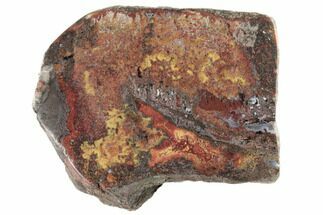This Specimen has been sold.
4.5" Polished Berber Agate - Morocco
This is a polished berber agate section that was collected from Morocco. It features the characteristic red, pink and white agate banding that's common for this agate location near Sidi Rahal, Morocco. It has been cut flat on one side and polished to a glossy finish. It comes with an acrylic display stand.
Berber agate, also known by some as Antelope Agate, is the trade name for an agate that is collected near Sidi Rahal, Morocco. They occur within Triassic basaltoids and have characteristic coloration and internal structures that make them easily identifiable by collectors. They typically feature a pink outer rim composed of opaque opal-CT, with red to red-brown interior layers that gain their color from iron impurities (goethite and hematite). The centers of these nodules are often blue-gray/white-grey and contain small amounts of moganite.
Agate is a variety of microcrystalline quartz (chalcedony) that displays translucence and, in some cases, banding. Agate primarily forms when silica-rich fluids fill pockets within rocks and/or fossils, depositing the silica along the walls of the rock. This process can result in banding patterns, as the compositions and impurities of these depositing fluids change over time. These banding patterns can either form as flat layers, creating linear patterns known as waterline agate, or as rounded layers, forming more common ring-like patterns. These patterns depend on the surfaces available for deposition.
Agate is a variety of microcrystalline quartz (chalcedony) that displays translucence and, in some cases, banding. Agate primarily forms when silica-rich fluids fill pockets within rocks and/or fossils, depositing the silica along the walls of the rock. This process can result in banding patterns, as the compositions and impurities of these depositing fluids change over time. These banding patterns can either form as flat layers, creating linear patterns known as waterline agate, or as rounded layers, forming more common ring-like patterns. These patterns depend on the surfaces available for deposition.
About Agate
Agate is a variety of microcrystalline quartz (chalcedony) that displays translucence and, in some cases, banding. Agate primarily forms when silica-rich fluids fill pockets within rocks and/or fossils, depositing the silica along the walls of the rock. This process can result in banding patterns, as the compositions and impurities of these depositing fluids change over time. These banding patterns can either form as flat layers, creating linear patterns known as waterline agate, or as rounded layers, forming more common ring-like patterns. These patterns depend on the surfaces available for deposition.
Agate is a variety of microcrystalline quartz (chalcedony) that displays translucence and, in some cases, banding. Agate primarily forms when silica-rich fluids fill pockets within rocks and/or fossils, depositing the silica along the walls of the rock. This process can result in banding patterns, as the compositions and impurities of these depositing fluids change over time. These banding patterns can either form as flat layers, creating linear patterns known as waterline agate, or as rounded layers, forming more common ring-like patterns. These patterns depend on the surfaces available for deposition.
SPECIES
Chalcedony var. Agate
LOCATION
Sidi Rahal, Morocco
SIZE
4.5 x 2.9", up to 1.15" thick
CATEGORY
SUB CATEGORY
ITEM
#181031
 Reviews
Reviews













